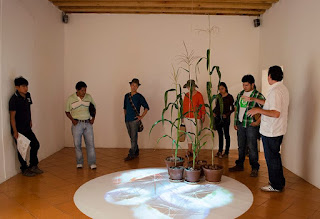In the fourth event that I attended, Dr. María Antonia González Valerio, from the National Autonomous University of Mexico, held a lecture on combining humanities, arts, and sciences to help educate the world and create a third culture. In her lecture there was two parts, the philosophical part (which is her favorite subject) and then the part where she explains what projects her and her team have done.
 |
| http://gastv.mx/16980/ |
Philosophically she proses a lot of questions about how can we use biotechnology and art to raise awareness in the world. Specifically her and her team looked at the use of Genetically Modified Organisms (GMO) in agriculture. GMOs are genetically engineered plants or animals that have been altered at the gene level. They are used to create a bigger and better plant or animal but usually at the organisms’ own expense. Such as chickens who are genetically modified with bigger breasts, which are so big that they cannot walk around. In Mexico María is concerned abut the use of GMOs in corn. The project called “Bioartefactos: Desgranar lentamente un maíz”, brings awareness that genetically engineering corns is not natural with the culture. According to the projects GMOs “forget that food is also identity and memory. Some say that the country is a matter of smells and tastes, and thinking about it, homogenize corn is oblations and subjects” (GASTV).
 |
| http://gastv.mx/16980/ |
Her work with biotechnology + art has become a success in reading awareness for an unjust cause. With her group she will be able to educate people thus making the world a better place. I would recommend looking into her other projects because it is interesting to see how she was able to create a third culture.
 |
| from my iPhone |
Cite:
Cruz, Gustavo. "Bioartefactos. Desgranar Lentamente Un Maíz." GAS TV. 2014. Web. 03 June 2016.
"Building the Platform for Interdisciplinary Projects at the National Autonomous University of Mexico." UCLA Design Media Arts. 26 May 2016. Web. 03 June 2016.
BIOARTEFACTOS. Bioartefactos: Desgranar Lentamente Un Maíz, Museum of Contemporary Art of Oaxaca.
Mateljan, George. "What Does GMO Mean?" The World's Healthiest Foods. George Mateljan Foundation, 30 May 2016. Web. 3 June 2016.
Uconlineprogram. "5 Bioart Pt1 1280x720." YouTube. YouTube, 18 Sept. 2013. Web. 04 May 2016.






















